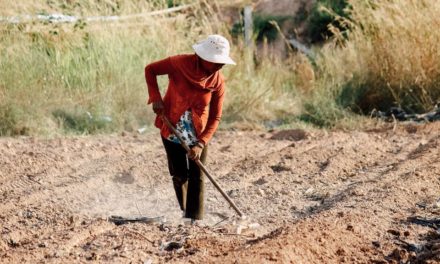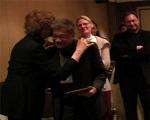By Walden Bello*
From Common Dreams, April 23, 2010
The issue of corruption is a very resonant one in developing countries. In the Philippines, for instance, the slogan of the coalition that is likely to win the 2010 presidential elections is “Without corrupt officials, there are no poor people.”
Not surprisingly, the international financial institutions have weighed in. The World Bank has made “good governance” a major thrust of its work, asserting that the “World Bank Group focus on governance and anticorruption (GAC) follows from its mandate to reduce poverty—a capable and accountable state creates opportunities for poor people, provides better services, and improves development outcomes.” (1)
There is no doubt that corruption is to be condemned and corrupt officials resolutely prosecuted because it erodes trust in government. It also weakens the moral bonds of civil society on which democratic practices and processes rest. But while research suggests that corruption has some bearing on the spread of poverty, the claim that corruption is the principal cause of poverty and economic stagnation, although popular with voters, is questionable.
World Bank and Transparency International data show that the Philippines and China exhibit the same level of corruption, yet China grew by 10.3 per cent per annum between 1990 and 2000 while the Philippines grew by only 3.3 per cent. Moreover, as a recent study by Shaomin Lee and Judy Wu shows, “China is not alone; there are other countries that have relatively high corruption and high growth rates.” (2)
Limits of a Hegemonic Narrative
The “corruption-causes-poverty narrative” has become so hegemonic that it has often marginalized policy issues from political discourse. One key reason is that it appeals to the elite and middle class, which dominate the articulation of public opinion. It is also a safe language of political competition among politicians, that is, one that they can deploy for electoral effect against one another without arousing the destabilizing effects of a discourse based on class.
Yet it is a discourse that has increasingly less appeal to the poorer classes. Despite the corruption that marked his reign, Joseph Estrada is running a respectable third in the presidential contest in the Philippines, with solid support among many urban poor communities. But it is perhaps in Thailand where the lower classes have rejected most decisively the corruption discourse, which the elites and Bangkok-based middle class deployed to oust Thaksin Shinawatra from the premiership in 2006.
While in power, Thaksin brazenly used his office to enlarge his corporate empire, but the rural masses and urban lower classes—the base of the so-called “Red Shirts”–have ignored this and are fighting to restore his coalition to power. The reason is that they remember the Thaksin period from 2001 to 2006 as one where Thailand recovered from the Asian financial crisis owing to Thaksin’s kicking out the International Monetary Fund (IMF) and his promotion of expansionary policies with a redistributive dimension, such as cheap universal health care, a one-million-baht development fund for each town, and a moratorium on farmers’ servicing of their debt. These policies made a difference in their lives.
Thaksin’s Red Shirts are probably right in their implicit assessment that when it comes to addressing poverty, pro-people policies are more decisive than corruption. Indeed, in Thailand and elsewhere, clean-cut technocrats have probably been responsible for greater poverty than the most corrupt politicians. And one suspects that one of the reasons the corruption-causes-poverty discourse is so popular with the elites and the international financial institutions is that it serves as a smokescreen for the structural causes of poverty and stagnation and for wrong policy choices.
Bad Policies and Poverty: the Philippine Case
The case of the Philippines since 1986 is illustrative of the greater explanatory power of the “wrong-policy narrative” than the corruption narrative. In contrast to an ahistorical narrative that sees massive corruption as having suffocated the promise of the post-Marcos democratic republic, the wrong-policy narrative locates the key causes of Philippine underdevelopment and poverty in historical events and developments.
The complex of policies that have pushed the Philippines into the economic quagmire over the last 30 years might be summed up in that formidable term: structural adjustment. Also known as neoliberal restructuring, it involved prioritization of debt repayment; conservative macroeconomic management involving huge cutbacks in government spending; trade and financial liberalization; privatization and deregulation; and export-oriented production. Structural adjustment came to the Philippines courtesy of the World Bank, International Monetary Fund, and the World Trade Organization, but it was internalized and disseminated as doctrine by local technocrats and economists.
Corazon Aquino was personally honest—indeed the epitome of non-corruption–and her contribution to the reestablishment of democracy was indispensable, but her submitting to the International Monetary Fund’s (IMF) demand to prioritize debt repayment over development brought about a decade of stagnation and continuing poverty. Interest payments as a percentage of total government expenditures went from 7 per cent in 1980 to 28 per cent in 1994. Capital expenditures, on the other hand, plunged from 26 per cent to 16 per cent. Since government is the biggest investor in the Philippines—indeed in any economy—the radical stripping away of capital expenditures goes a long way toward explaining the stagnant one per cent average yearly growth in gross domestic product in the 1980’s and the 2.3 per cent rate in the first half of the 1990’s.
In contrast, the Philippines’ Southeast Asian neighbors ignored the IMF’s prescriptions. They limited debt servicing while ramping up government capital expenditures in support of growth. Not surprisingly, they grew by 6 to 10 per cent from 1985 to 1995, attracting massive Japanese investment while the Philippines barely grew and gained the reputation of a depressed market that repelled investors.
When Aquino’s successor, Fidel Ramos, came to power in 1992, the main agenda of his technocrats was to bring down all tariffs to 0 to 5 per cent and bring the Philippines into the World Trade Organization and the Asean Free Trade Area (AFTA), moves that were intended to make trade liberalization irreversible. A pick-up in the growth rate in the early years of Ramos sparked hope, but the green shoots were more apparent than real, and they were, at any rate, crushed as a result of another neoliberal policy: financial liberalization. The elimination of foreign exchange controls and restrictions of speculative investment attracted billions of dollars in the period 1993-1997. But this also meant that when panic hit the ranks of foreign investors in Asia in the summer of 1997, the same lack of capital controls facilitated the stampede of billions of dollars from the country in a few short weeks in mid-1997. This pushed the economy into recession and stagnation in the next few years.
The administration of the next president, Joseph Estrada, did not reverse course, and under the presidency of Gloria Macapagal Arroyo, neoliberal policies continued to reign. New liberalization initiatives in the next few years were initiated on the trade front, with the government negotiating free trade agreements with Japan and China. These pacts were entered into despite clear evidence that trade liberalization was destroying the two pillars of the economy, industry and agriculture.
Radical unilateral trade liberalization severely destabilized the Philippines’ manufacturing sector, with textile and garments firms, for instance, being drastically reduced from 200 in 1970 to 10 in recent years. As one of Arroyo’s finance secretaries admitted, “there’s an uneven implementation of trade liberalization, which was to our disadvantage.” While he speculated that consumers might have benefited from the tariff liberalization, he acknowledged that “it has killed so many local industries.”
As for agriculture, the liberalization of the country’s agricultural trade after the country joined the World Trade Organization in 1995 transformed the Philippines from a net food exporting country and consolidated it into a net food importing country after the mid-1990’s. The year 2010 is the year that the China ASEAN Trade Agreement (CAFTA) negotiated by the Arroyo administration goes into effect, and the prospect of cheap Chinese produce flooding Philippines markets has made Filipino vegetable farmers fatalistic about their survival.
What likewise became clear during the long Arroyo reign were the stifling effects of the debt repayment-oriented macroeconomic management policy that came with structural adjustment. With 20-25 per cent of the national budget reserved for debt service payments owing to the draconian Automatic Appropriations Law, government finances were in a state of permanent and widening deficit, which the administration tried to solve by contracting more loans. Indeed, the Arroyo administration contracted more loans than the previous three administrations combined.
When the deficit reached gargantuan proportions, the government refused to take the necessary steps to contain the key factor acting as the main drain on expenditures; that is, it refused to declare a debt moratorium or at least renegotiate the terms of debt repayment to make them less punitive. At the same time, the administration did not have the political will to force the rich to take the brunt of bridging the deficit by increasing taxes on their income and improving their collection. Under pressure from the IMF, the government levied this burden on the poor and the middle class via the adoption of the expanded value added tax (EVAT) of 12 per cent on purchases. The tax was passed on to poor and middle class consumers by commercial establishments, forcing them to cut back on consumption, which then boomeranged back on small merchants and entrepreneurs in the form of reduced profits, forcing many out of business.
The straitjacket of conservative macroeconomic management, trade and financial liberalization, and a subservient debt policy kept the economy from expanding significantly, resulting in the percentage of the population living in poverty increasing from 30 to 33 per cent between 2003 and 2006, according to World Bank figures. By 2006, there were more poor people in the Philippines than at any other time in the country’s history.
Policy and Poverty in the Third World
The Philippine story is paradigmatic. Many countries in Latin America, Africa, and Asia saw the same story unfold. Taking advantage of the Third World debt crisis, the IMF and the World Bank imposed structural adjustment in over 70 developing countries in the course of the 1980’s. Trade liberalization followed adjustment in the 1990’s as developing countries were dragooned into the World Trade Organization and later into free trade agreements with rich countries.
The results:
– The gains in economic growth and poverty reduction posted by the developing countries in the 60’s and 70’s were wiped out in the 80’s and 90’s.
– In practically all structurally adjusted countries, huge swathes of industry were wiped out by trade liberalization, and countries enjoying a surplus in agricultural trade were turned into and consolidated into deficit countries.
– By the beginning of the millennium, the number of people living in extreme poverty had increased globally by 28 million from the decade before. The number of poor increased in Latin America and the Caribbean, Central and Eastern Europe, the Arab states, and sub-Saharan Africa. The reduction in the number of the word’s poor mainly occurred in China and those countries of East Asia that spurned the policies of structural adjustment and trade liberalization that were imposed on the Philippines and other developing economies by the multilateral institutions and local neoliberal technocrats.
China and the rapidly growing newly industrializing countries of East and Southeast Asia where most of the global reduction in poverty took place were marked by high degrees of corruption, so it is inescapable that what made the decisive difference between their performance and that of countries that were subjected to structural adjustment was economic policy.
Corruption erodes the credibility of government and weakens the moral bonds pm which democratic governance rests. That is why it must be denounced and corrupt officials must be resolutely prosecuted. But corruption is not the main cause of poverty, and challenge of poverty will not be met by the “anti poverty, anti-corruption” crusades that so enamor the middle classes and the World Bank. Bad economic policies create and entrench poverty, and unless the policies of structural adjustment, trade liberalization, and conservative macroeconomic management are reversed, there is no escaping the poverty trap. 1) Guiding Principles for Strengthening World Bank Group Engagement on Governance and Anticorruption
2) www.informaworld.com; DOI:10.1080/09692290802577446
*FPIF columnist Walden Bello is representative of the party-list Akbayan in the Philippine House of Representatives. He can be contacted at [email protected]
(this email address is being protected from spam bots, you need Javascript enabled to view it).









